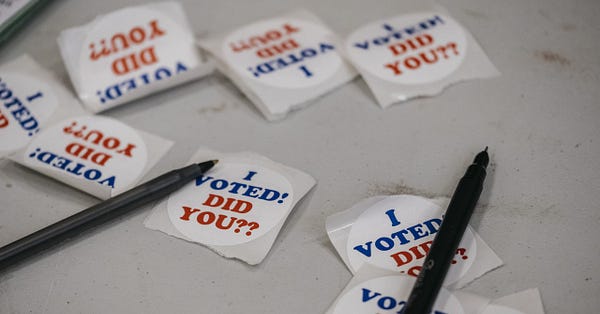The Misunderstood Inclusionist
On being labeled a radical, a joke, but generally a likable person.

[Image Description] a very cute brown and black german shepherd puppy with its head tilted
Hey Y’all,
Have you ever felt misunderstood? Like you were trying to get your message across but no matter how hard you tried, people weren’t receiving it?

[GIF Description] a character from the CBC show Kim’s Convenience says, “I don’t think we’re talking about the same thing.”
In 2011, I was approached by the Georgia Department of Education (GaDOE) through the Cobb County School District to participate in a pilot inclusion program for students with significant disabilities. In case you didn’t know already (according to the most recent data) Georgia includes 64% of students with disabilities 80% of the time or more in general education. The program was an effort by the GaDOE to address the problem of segregating too many students with disabilities.
After selecting the student, a first-grader named Damian, the team at my elementary school worked with a consultant to plan for the inclusion of the student with multiple disabilities in general education. The principal, the general education teacher, the related service providers, paraprofessionals, and the family were on board. We were going to make it work!
And for the most part, it did work. The success was in large part to the paraprofessionals that worked tirelessly to make Damian’s time in general education as meaningful as possible. Even though I still taught in a classroom for students with significant disabilities, where the majority of them spent all day in my classroom, at least Damian was being included. I thought it was a win for inclusion.
If you asked around the school, you would definitely have people who were supportive of the pilot program, and who said I was a very nice person. But I got word from some of my inclusion allies that some skeptics thought it was a joke and farce that Damian was being subjected to being in general education for any portion of the day. I mean, what was he getting out of being in a regular classroom anyway?
By the time Damian entered the fifth grade, he was included for 80% or more of his day in general education. And though I look back on his time and what we accomplished as a team with fondness, my dream for inclusive education wasn’t fully realized. When I left the school for another position in the district, did educators follow my lead and push for full inclusion of students with significant disabilities? I think they did their best. But what was missing was any pressure from outside the district or from the special education administration to keep the program going.
In my subsequent positions in the district, I was rarely consulted by special education leadership on how to move us toward inclusive practices, despite writing and speaking on the subject for close to a decade. There was one instance where one of my supervisors had to sit me down and tell me that my message that inclusion was for all students wasn’t the district’s message and that I should be careful when I give opinions in IEP meetings. But did anyone ask me what I actually meant by inclusive education? No.
When you are an inclusionist, the assumption is that you are a radical that wants to get rid of special education entirely without replacing it with anything better. I recently wrote about this for Think Inclusive as a response to a writer in Psychology Today calling out my thoughts on why special education isn’t working.
An assumption that is common with people who push back on inclusive education is that inclusion can be achieved without changing the system that perpetuates segregation by disability in the first place. Saying that inclusion doesn’t work without the proper support for educators and students is like being upset that a broken arm didn’t heal correctly despite a cast never being put on it.
Being able to refine my view even further now that I am with MCIE, I believe you can be an “inclusionist” and not opposed to “pull-out” instruction if it is part of a school-wide framework for meeting learning needs for all students and not just in a segregated special education classroom. When we talk about reimaging schools, why aren’t we are talking about this?
Why is it that only students with identified needs can get an intervention? Progressive schools can respond to the diverse needs of their students whether or not they have an Individualized Education Program (IEP). Small group instruction is not only a special education strategy and can facilitate individualized pre-teaching, re-teaching, or fine-tuning of the academic skills needed for learning.
Moving toward inclusive education doesn’t mean getting rid of special education services. It means creating school-wide supports that address the needs of all students.
Don’t think it can be done?
These schools and districts would beg to differ (to name just a few).
West Linn - Wilsonville School District
Groton-Dunstable Regional School District
Early Emory Center for Child Development and Enrichment
Tapestry Public Charter School
New Podcast!
Do you need an example of what we are talking about?
Check out our interview with Jennifer Spencer-Iiams, Assistant Superintendent for the West Linn-Wilsonville School District who talks to us about the transformation in her district toward inclusive practices. Her book, Leading for All: How to Create Truly Inclusive and Excellent Schools, shares lessons learned from years building district schools where all students are served in their neighborhood school and classrooms with their general education peers.
Leading for All: How to Create Truly Inclusive and Excellent Schools
Have a fantastic week everyone!
Tim
If you are new to The Weeklyish. Welcome! To support our work, use the button below to donate to MCIE, where we receive direct support for Think Inclusive, The Weeklyish, and the Think Inclusive Podcast. Your tax-deductible donation goes far to help us share MCIE’s work, best practices for inclusive education, and systems change.
ICYMI
How to Create Truly Inclusive and Excellent Schools with Jennifer Spencer-Iiams
Inclusion Goes Viral: How One Teacher Designed Her Inclusive Classroom
Mainstreaming. Works. For. No. One.
9 Inclusive Education Resources to Share With School and Community Leaders
In The News
Influential literacy expert Lucy Calkins is changing her views
Schools Fail To Curtail Restraint, Seclusion Of Students With Disabilities
At the U.S. Olympic and Paralympic Museum, All Athletes Are Equal
What I’m Reading
Why Humans Totally Freak Out When They Get Lost
The Hardest Part of Being Disabled is Being Ignored
Crime rose unevenly when stay-at-home orders lifted. The racial disparity is the widest in years.
BYU-Idaho says students may be trying to get COVID-19 so they can sell their plasma
What I’m Watching
What I’m Listening To
Disability Visibility Podcast - Ep 88: Policy
What’s in my Timeline



